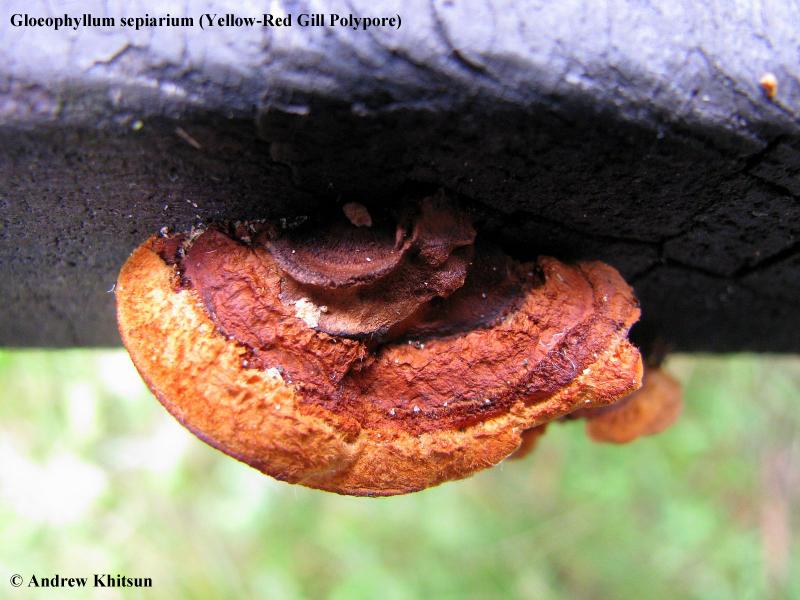|
Gloeophyllum sepiarium
[ Basidiomycetes > Polyporales > Gloeophyllaceae > Gloeophyllum . . . ] by Michael Kuo Decomposing the deadwood of conifers across North America, Gloeophyllum sepiarium is fairly easily recognized. When fresh and very young its cap is more or less orange, but as it matures brown colors replace the orange from the center outwards. The underside of this polypore features gills–which is a bit odd, since polypores have pores rather than gills! (For help sorting through this mess, see the essay on the page for Lenzites betulina, another “gilled polypore.”) Other distinguishing features include the brown flesh and the black reaction to KOH, as well as microscopic features. Description: Ecology: Saprobic on the deadwood of conifers and, occasionally, hardwoods (especially those, like quaking aspen, that grow in conifer-dominated ecosystems); causing a brown rot; growing alone or gregariously; appearing in woods, but not infrequently found on lumber in urban settings; annual or reviving to be perennial; summer and fall (and over winter in warm climates); widely distributed in North America. Cap: Single or compound (and then either fused laterally or with loosely arranged lobes arising from a central point); up to about 12 cm across and 8 cm deep; semicircular, irregularly bracket-shaped, or kidney-shaped; flattened-convex; velvety to hairy; rugged; with concentric zones of texture and color; at first yellow to orange, becoming yellow-brown to dark brown or nearly black toward the point of attachment but usually remaining yellow to orange on the growing margin. Gills: Irregular and often fusing; fairly close; often mixed with slot-like pores; edges yellow-brown becoming darker brown with age; faces creamy to pale brownish, darkening with age; up to about 1 cm deep. Stem: Absent Flesh: Dark rusty brown or dark yellow-brown; corky. Chemical Reactions: KOH black on flesh. Spore Print: White. Kuo, M. (2010, February). Gloeophyllum sepiarium. Retrieved from the MushroomExpert.Com Web site: http://www.mushroomexpert.com/gloeophyllum_sepiarium.html |
|
If You Suspect a Poisoning
If you suspect you have consumed a poisonous mushroom, contact a physician, the closest hospital ER, poison control center, or dial 911, depending on the severity of the reaction. US Poison Control: 1-800-222-1222 The North American Mycological Association (NAMA) has information that may also be of help. Click here. We do not ID mushrooms through this website.
If you are in need of an ID consider uploading quality photos with multiple views of your specimen and descriptions of your find to Mushroom Observer or iNaturalist including our projects or post in Wild Food Wisconsin or Mushroom Identification Group. If you contact us and provide a way to get back to you, we may be able to provide suggestions for more identification resources you can use. You are always responsible for your own decisions taken on the basis of identification resources. |
Wisconsin Mycological Society (WMS) is dedicated to the study and enjoyment of mushrooms and other fungi throughout the state of Wisconsin. Education, safety, sustainability, community, and connecting with nature are our goals.
|


 RSS Feed
RSS Feed
